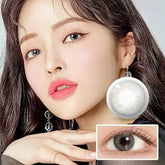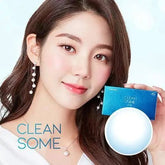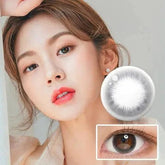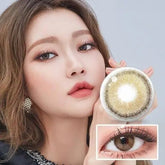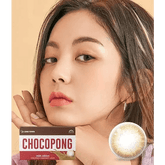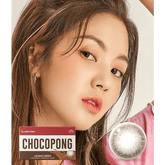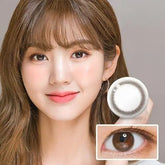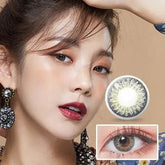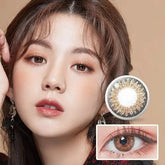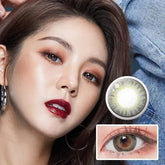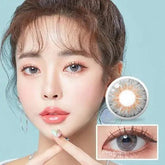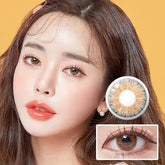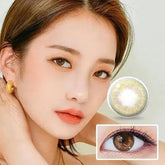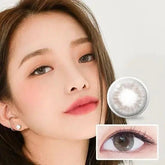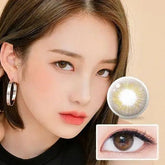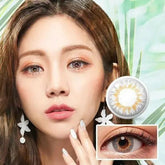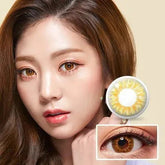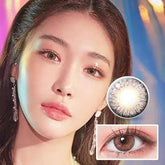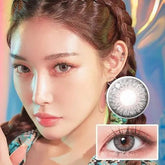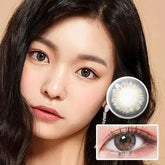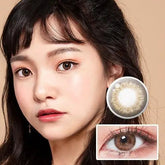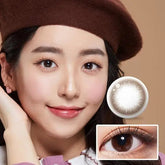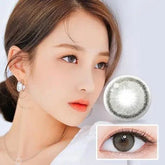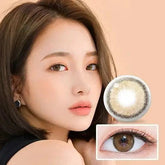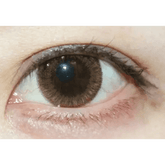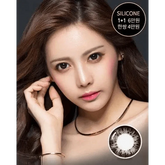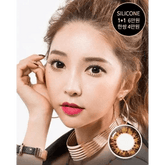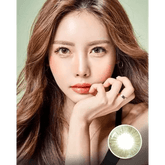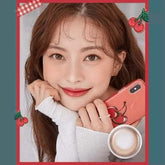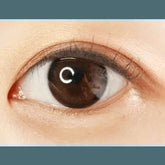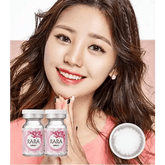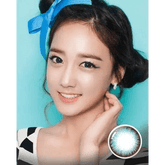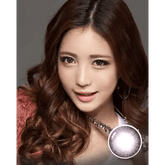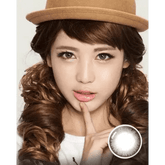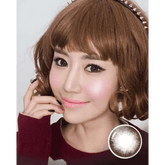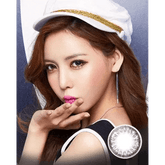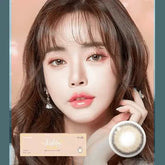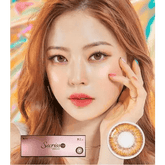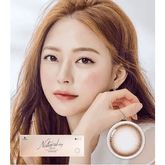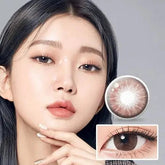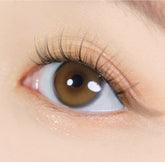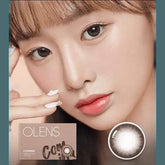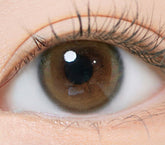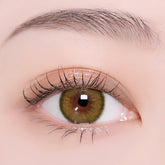-
Vendor:LENSTOWN
LensTown Coco view Blurring Gray
🌟 LensTown Coco View Blurring Gray – Effortless Elegance in Every Blink Elevate your style with LensTown Coco View Blurring Gray. With its subtle yet captivating gray tone, LensTown Coco View Blurring Gray enhances your natural look, adding depth and charm to your gaze. Perfect for daily...- $39.99
$46.00- $39.99
- Unit price
- per
Save $6.01 -
Vendor:LENSTOWN
LensTown Clean Some Clear
🌟 LensTown Clean Some Clear – Pure Vision with Maximum Comfort LensTown Clean Some Clear offers the perfect blend of clarity and comfort, ideal for daily use. Designed to provide a crisp, unobstructed view, LensTown Clean Some Clear is your go-to for simple yet effective vision correction....- $28.99
$40.00- $28.99
- Unit price
- per
Save $11.01 -
Vendor:LENSTOWN
LensTown Circlean Big Black
🌟 LensTown Circlean Big Black – Bold, Captivating Eyes Transform your gaze with LensTown Circlean Big Black lenses. With a rich, deep black hue, LensTown Circlean Big Black amplifies the natural allure of your eyes, making them appear larger and more defined. Perfect for both daily wear and...- $33.99
$40.00- $33.99
- Unit price
- per
Save $6.01 -
Vendor:LENSTOWN
LensTown Choco Pong Edge Milk Choco
🌟 LensTown Choco Pong Edge Milk Choco – Soft and Natural Chocolate Charm Indulge in the creamy elegance of LensTown Choco Pong Edge Milk Choco, a lens designed to give your eyes a soft, natural charm with its rich milk chocolate hue. Every pair of LensTown...- $28.99
$40.00- $28.99
- Unit price
- per
Save $11.01 -
Vendor:LENSTOWN
LensTown Choco Pong Milk Choco
🌟 LensTown Choco Pong Milk Choco – Embrace Natural Warmth in Every Glance Discover the enchanting softness of LensTown Choco Pong Milk Choco lenses, designed to give your eyes a warm, inviting glow with subtle brown tones. Perfect for daily wear, these lenses bring out the...- $28.99
$40.00- $28.99
- Unit price
- per
Save $11.01 -
Vendor:LENSTOWN
LensTown Choco Pong Caramel Choco
🌟 LensTown Choco Pong Caramel Choco – Effortless Sweetness for Every Occasion LensTown Choco Pong Caramel Choco brings a warm caramel touch to your eyes, ideal for a natural enhancement that adds depth and charm to your daily look. With a soft yet striking effect, LensTown...- $28.99
$40.00- $28.99
- Unit price
- per
Save $11.01 -
Vendor:LENSTOWN
LensTown Nudy Coco Brown Toric
🌰 Vision Meets Style with LensTown Nudy Coco Brown Toric Contacts Achieve perfect clarity and a touch of natural elegance with LensTown Nudy Coco Brown Toric lenses. Designed to correct astigmatism, these Brown Contacts combine style with vision correction for a comfortable and clear experience. With a 38% water...- $59.99
$80.00- $59.99
- Unit price
- per
Save $20.01 -
Vendor:LENSTOWN
LensTown Bombi Gray
🌟 LensTown Bombi Gray – Effortlessly Enhance Your Style with Soft Gray Elegance Add a touch of sophistication to your look with LensTown Bombi Gray. These monthly lenses bring a gentle gray tone that complements any eye color, creating a naturally refined appearance. With a...- $17.99
$28.00- $17.99
- Unit price
- per
Save $10.01 -
Vendor:LENSTOWN
LensTown Bombi Brown
🌟 LensTown Bombi Brown – Add Warmth and Subtle Beauty to Every Day Enhance your eyes with the natural charm of LensTown Bombi Brown. These monthly lenses bring a soft brown hue, perfect for a warm and inviting look that complements any style. With a...- $17.99
$27.00- $17.99
- Unit price
- per
Save $9.01 -
Vendor:LENSTOWN
LensTown Back to Basic July Gray
🌟 LensTown Back to Basic July Gray – Classic Elegance with Subtle Gray Tones Transform your everyday look with the understated beauty of LensTown Back to Basic July Gray. With a soft, natural gray hue, LensTown Back to Basic July Gray adds a touch of elegance for...- $28.99
$31.00- $28.99
- Unit price
- per
Save $2.01 -
Vendor:LENSTOWN
LensTown Back to Basic July Brown
🌟 LensTown Back to Basic July Brown – Warm and Natural Beauty for Every Day Embrace a naturally elegant look with LensTown Back to Basic July Brown. These high-quality lenses blend warmth and subtle color to enhance your eyes for any occasion. With a comfortable...- $28.99
$31.00- $28.99
- Unit price
- per
Save $2.01 -
Vendor:LENSTOWN
LensTown Back to Basic Avenue Deep Gray
🌟 LensTown Back to Basic Avenue Deep Gray – Refined Depth for Every Look Experience a new level of sophistication with LensTown Back to Basic Avenue Deep Gray. These lenses offer a deep gray shade that beautifully complements your natural eye color, adding subtle depth...- $28.99
$42.00- $28.99
- Unit price
- per
Save $13.01 -
Vendor:LENSTOWN
LensTown Aqua Fit Gray
🌟 LensTown Aqua Fit Gray – Elevate Your Look with Natural Gray Elegance Discover the subtle sophistication of LensTown Aqua Fit Gray. This monthly contact lens brings a refined touch to any look, combining premium comfort with a soft gray tint that naturally enhances your...- $19.99
$30.00- $19.99
- Unit price
- per
Save $10.01 -
Vendor:LENSTOWN
LensTown Aqua Fit Brown
🌟 LensTown Aqua Fit Brown – The Perfect Monthly Lens for Subtle Elegance Transform your everyday look with LensTown Aqua Fit Brown. Designed for a monthly wear schedule, LensTown Aqua Fit Brown lenses provide a soft, natural brown tint that enhances your eye’s beauty with an elegant...- $19.99
$30.00- $19.99
- Unit price
- per
Save $10.01 -
Vendor:LENSTOWN
LensTown 247 With Me Olive (10p)
🌟 LensTown 247 With Me Olive (10p) – Subtle Charm with a Hint of Green Enhance your everyday look with the soft, natural elegance of LensTown 247 With Me Olive (10p). Designed for daily wear, these lenses provide a delicate olive tint that complements any...- $23.99
$35.00- $23.99
- Unit price
- per
Save $11.01 -
Vendor:LENSTOWN
LensTown 247 With Me Gray (10p)
🌟 LensTown 247 With Me Gray (10p) – Subtle, Everyday Elegance in Gray Experience the delicate, yet impactful beauty of LensTown 247 With Me Gray (10p). These lenses deliver a soft gray hue that enhances natural beauty, offering all-day comfort with a perfect blend of...- $23.99
$35.00- $23.99
- Unit price
- per
Save $11.01 -
Vendor:LENSTOWN
LensTown 247 With Me Brown (10p)
🌟 LensTown 247 With Me Brown (10p) – Perfect Blend of Comfort and Style Elevate your look with LensTown 247 With Me Brown (10p), offering a natural and sophisticated brown hue that enhances your eyes effortlessly. With a 38% water content and daily disposable design, LensTown 247 With Me...- $23.99
$35.00- $23.99
- Unit price
- per
Save $11.01 -
Vendor:LENSTOWN
LensTown Aloha Candy Gray
🌟 LensTown Aloha Candy Gray – Subtle Elegance with a Touch of Bold Gray Transform your gaze with LensTown Aloha Candy Gray, a monthly lens that adds a soft yet striking gray tint to elevate your everyday style. Designed for those who seek a balance...- $17.99
$26.00- $17.99
- Unit price
- per
Save $8.01 -
Vendor:LENSTOWN
LensTown Aloha Candy Brown
🌟 LensTown Aloha Candy Brown – Vibrant Brown for a Sweet, Bold Look Transform your style with the eye-catching LensTown Aloha Candy Brown lenses, designed to add a hint of sweetness to your gaze. These monthly lenses bring a unique, vibrant brown hue that enhances your...- $17.99
$26.00- $17.99
- Unit price
- per
Save $8.01 -
Vendor:LENSTOWN
LensTown 247 Fit Pink (10p)
🌸 LensTown 247 Fit Pink (10p) – A Soft Pink Glow for Every Occasion Add a touch of rosy elegance to your look with LensTown 247 Fit Pink (10p). These lenses are crafted to enhance your eyes with a delicate pink tint, bringing out a...- $23.99
$35.00- $23.99
- Unit price
- per
Save $11.01 -
Vendor:LENSTOWN
LensTown 247 Fit Gray (10p)
🌟 LensTown 247 Fit Gray (10p) – Effortless Sophistication in Gray Transform your look with the refined elegance of LensTown 247 Fit Gray (10p). Designed for those seeking a subtle yet impactful change, LensTown 247 Fit Gray (10p) lenses offer natural gray tones, all-day comfort, and effortless...- $23.99
$35.00- $23.99
- Unit price
- per
Save $11.01 -
Vendor:LENSTOWN
LensTown 247 Diary Gray (10p)
🌟 LensTown 247 Diary Gray (10p) – Everyday Elegance in Subtle Gray Add a sophisticated touch to your look with LensTown 247 Diary Gray (10p). These lenses are designed to provide a soft, subtle gray hue, making LensTown 247 Diary Gray (10p) perfect for a refined and...- $23.99
$35.00- $23.99
- Unit price
- per
Save $11.01 -
Vendor:LENSTOWN
LensTown 247 Diary Brown (10p)
🌟 LensTown 247 Diary Brown (10p) – A Touch of Warmth for Your Daily Look Elevate your everyday style with the natural charm of LensTown 247 Diary Brown (10p). These lenses are designed to provide a soft, brown hue that complements any skin tone, making LensTown...- $23.99
$35.00- $23.99
- Unit price
- per
Save $11.01 -
Vendor:LENSTOWN
LensTown 17Again Choco
🌟 LensTown 17Again Choco – Enhance Your Natural Charm with Lasting Comfort Embrace the natural elegance of LensTown 17Again Choco. Crafted for those who desire subtle charm, these monthly lenses provide a warm, soft choco tone that brings depth to your look. Enjoy daily...- $14.99
$27.00- $14.99
- Unit price
- per
Save $12.01 -
Vendor:LENSTOWN
LensTown Romantea Rose Charcoal Gray
🌌 Embrace a Bold Look with LensTown Romantea Rose Charcoal Gray Transform your style with the mesmerizing LensTown Romantea Rose Charcoal Gray lenses, crafted for those who desire a subtle yet impactful enhancement. Featuring a rich blend of charcoal and gray tones, LensTown Romantea...- $29.99
$40.00- $29.99
- Unit price
- per
Save $10.01 -
Vendor:LENSTOWN
LensTown Romantea Rose Beige Brown
🌹 Enhance Your Natural Glow with LensTown Romantea Rose Beige Brown Step into elegance with LensTown Romantea Rose Beige Brown lenses, crafted for those who appreciate a blend of subtle warmth and sophistication. The LensTown Romantea Rose Beige Brown lenses feature a harmonious fusion...- $29.99
$40.00- $29.99
- Unit price
- per
Save $10.01 -
Vendor:OLENS
Olens SCL HI Brown
🤎 Add Warm Depth with Olens SCL HI Brown: Long-Lasting Brown Contacts Enhance your gaze with the subtle charm of Olens SCL HI Brown. These Brown Contacts offer a natural, elegant enhancement suitable for any occasion. With prescription options from 0.00 to -10.00, Olens SCL HI Brown provides clear vision...- $29.99
$41.00- $29.99
- Unit price
- per
Save $11.01 -
Vendor:OLENS
Olens Newtra Gray
✨ Elevate Your Look with Olens Newtra Gray 🎯 1. Achieve Subtle Sophistication with Olens Newtra Gray Transform your appearance effortlessly with Olens Newtra Gray lenses. These lenses feature a refined gray tone that enhances your eyes naturally, making Olens Newtra Gray perfect for both casual and formal...- $25.99
$41.00- $25.99
- Unit price
- per
Save $15.01 -
Vendor:OLENS
Olens Newtra Brown
✨ Discover a New You with Olens Newtra Brown 🎯 1. Enhance Your Natural Look with Olens Newtra Brown Elevate your style effortlessly with Olens Newtra Brown lenses. Perfectly crafted to blend natural beauty with subtle elegance, Olens Newtra Brown is ideal for any occasion, adding warmth and...- $25.99
$41.00- $25.99
- Unit price
- per
Save $15.01 -
Vendor:OLENS
Olens Seolem 3 Color Blue
🌊 Add Vibrant Elegance with Olens Seolem 3 Color Blue: Monthly Disposable Blue Contacts Transform your look with the mesmerizing charm of Olens Seolem 3 Color Blue. These Blue Contacts blend natural beauty with vibrant color, making them perfect for everyday wear or special occasions. With prescription options...- $24.99
$37.00- $24.99
- Unit price
- per
Save $12.01 -
Vendor:OLENS
Olens Seolem 3 Color Green
🍀 Add a Fresh Twist with Olens Seolem 3 Color Green: Long-Lasting Green Contacts Bring a natural glow to your eyes with Olens Seolem 3 Color Green. These Green Contacts offer a subtle yet refreshing enhancement, perfect for both daily wear and special moments. With prescription options ranging...- $24.99
$38.00- $24.99
- Unit price
- per
Save $13.01 -
Vendor:OLENS
Olens EyeTeen Gray
🌫️ Elevate Your Look with Olens EyeTeen Gray 🎯 1. Effortless Elegance with Olens EyeTeen Gray Achieve a sleek and modern look with Olens EyeTeen Gray lenses, perfect for those seeking subtle sophistication. Whether for everyday wear or special events, Olens EyeTeen Gray provides...- $28.49
$40.00- $28.49
- Unit price
- per
Save $11.51 -
Vendor:OLENS
Olens EyeTeen Brown
🌰 Achieve Youthful Radiance with Olens EyeTeen Brown 🎯 1. Effortless Style with Olens EyeTeen Brown Transform your everyday look with Olens EyeTeen Brown lenses, designed for those seeking a youthful, natural enhancement. Whether you’re heading to school or enjoying a day out, Olens...- $28.49
$40.00- $28.49
- Unit price
- per
Save $11.51 -
Vendor:OLENS
Olens Cherry Moon Gray
🌕 Olens Cherry Moon Gray – Embrace the Elegance of Olens Cherry Moon Gray The Olens Cherry Moon Gray lenses feature a sleek gray hue, perfect for those looking to add a touch of subtle sophistication to their style. With a 13.6mm graphic diameter,...- $28.49
$40.00- $28.49
- Unit price
- per
Save $11.51 -
Vendor:OLENS
Olens Cherry Moon Brown
🌕 Olens Cherry Moon Brown – Embrace the Glow of Olens Cherry Moon Brown The Olens Cherry Moon Brown lenses deliver a warm, captivating brown hue, perfect for enhancing your natural beauty. With a 13.6mm graphic diameter, Olens Cherry Moon Brown offers subtle enlargement...- $28.49
$40.00- $28.49
- Unit price
- per
Save $11.51 -
Vendor:OLENS
Olens Marble Brown
🌰 Transform Your Look with Olens Marble Brown 🎯 1. Embrace Warm Elegance with Olens Marble Brown Elevate your appearance with Olens Marble Brown, offering rich, warm brown tones that blend naturally with any look. Whether for casual settings or formal events, Olens Marble Brown ensures style...- $29.00
$38.00- $29.00
- Unit price
- per
Save $9.00 -
Vendor:OLENS
Olens Tika 3Con Gray
🌫️ Elevate Your Style with Olens Tika 3Con Gray: Monthly Gray Contacts Transform your look effortlessly with Olens Tika 3Con Gray lenses. These Olens Tika 3Con Gray lenses feature a sleek gray hue that complements any outfit. Designed with 40% water content, Olens Tika 3Con Gray keeps your eyes hydrated and...- $28.49
$40.00- $28.49
- Unit price
- per
Save $11.51 -
Vendor:OLENS
Olens Rara Gray
🌌 Unveil Subtle Sophistication with Olens Rara Gray 🎯 Elevate Your Look with Olens Rara Gray Achieve timeless elegance with Olens Rara Gray. These Gray Contacts offer a sleek, understated charm, perfect for both everyday wear and special occasions. Available in prescription options from 0.00 to -8.00, Olens Rara...- $9.99
$19.00- $9.99
- Unit price
- per
Save $9.01 -
Vendor:OLENS
Olens Polly Polly 4 Color Green
🌿 Embrace Nature’s Elegance with Olens Polly Polly 4 Color Green 🎯 Elevate Your Style with Olens Polly Polly 4 Color Green Transform your look with the vibrant charm of Olens Polly Polly 4 Color Green. Whether for casual outings or special events, Olens Polly Polly...- $43.00
$51.00- $43.00
- Unit price
- per
Save $8.00 -
Vendor:OLENS
Olens Polly Polly 4 Color Pink
🌸 Blossom with Elegance: Olens Polly Polly 4 Color Pink 🎯 Elevate Your Look with Olens Polly Polly 4 Color Pink Add a playful yet refined touch to your style with Olens Polly Polly 4 Color Pink. Whether for casual outings or glamorous events, Olens Polly...- $43.00
$51.00- $43.00
- Unit price
- per
Save $8.00 -
Vendor:OLENS
Olens Super Black
🖤 Bold Elegance with Olens Super Black: Monthly Black Contacts Transform your style with Olens Super Black lenses. These Olens Super Black lenses offer a deep, dramatic black hue, perfect for any occasion. With 38% water content, Olens Super Black ensures that your eyes stay hydrated throughout the day. Available in prescriptions...- $34.00
$43.00- $34.00
- Unit price
- per
Save $9.00 -
Vendor:OLENS
Olens Dali Extra Blue
🌊 Elevate Your Look with Olens Dali Extra Blue 🎯 1. Captivating Charm with Olens Dali Extra Blue Transform your gaze with Olens Dali Extra Blue lenses, designed to add vibrant depth and elegance to your eyes. These lenses offer a soft blue hue,...- $23.00
$36.00- $23.00
- Unit price
- per
Save $13.00 -
Vendor:OLENS
Olens Dali Extra Violet
🌸 Elevate Your Look with Olens Dali Extra Violet 🎯 1. Radiant Elegance with Olens Dali Extra Violet Unleash a bold new style with Olens Dali Extra Violet lenses. Offering a soft violet hue, these lenses add a unique touch of charm to your...- $29.00
$39.00- $29.00
- Unit price
- per
Save $10.00 -
Vendor:OLENS
Olens Dali Extra Gray
🌟 Elevate Your Look with Olens Dali Extra Gray 🎯 1. Subtle Sophistication with Olens Dali Extra Gray Enhance your natural beauty effortlessly with Olens Dali Extra Gray lenses. Offering a soft gray hue, these lenses add depth and elegance to your eyes, perfect...- $21.99
$34.00- $21.99
- Unit price
- per
Save $12.01 -
Vendor:OLENS
Olens Tok Tok Sugar Gray
❄️ Add a Crisp Edge to Your Style with Olens Tok Tok Sugar Gray: Monthly Gray Contacts Step up your look with Olens Tok Tok Sugar Gray lenses. These Olens Tok Tok Sugar Gray lenses, with their cool gray tones, add a touch of elegance to any outfit....- $22.00
$35.00- $22.00
- Unit price
- per
Save $13.00 -
Vendor:OLENS
Olens Cherry Nut Brown
🌰 Olens Cherry Nut Brown – Dive into Natural Beauty with Olens Cherry Nut Brown The Olens Cherry Nut Brown lenses offer a warm, nutty brown hue, perfect for those who want to enhance their natural beauty subtly. With a 13.6mm graphic diameter, Olens...- $29.00
$38.00- $29.00
- Unit price
- per
Save $9.00 -
Vendor:OLENS
Olens Clearing Black
🖤 Elevate Your Look with Olens Clearing Black 🎯 1. Subtle Definition with Olens Clearing Black Transform your eyes effortlessly with Olens Clearing Black lenses. These monthly lenses provide a rich black hue that enhances your eye shape and adds depth to your gaze....- $29.00
$39.00- $29.00
- Unit price
- per
Save $10.00 -
Vendor:OLENS
Olens Clearing Choco
🍫 Elevate Your Look with Olens Clearing Choco 🎯 1. Subtle Charm with Olens Clearing Choco Experience the warm elegance of Olens Clearing Choco. These monthly lenses feature a soft chocolate hue that enhances your natural eye color, adding depth and radiance. Whether you’re...- $29.00
$38.00- $29.00
- Unit price
- per
Save $9.00 -
Vendor:OLENS
Olens Pi 2 Gray
✨ Transform Your Look with Olens Pi 2 Gray 🎯 Elevate Your Style with Olens Pi 2 Gray Enhance your gaze with the sophisticated charm of Olens Pi 2 Gray. Whether for everyday wear or special moments, Olens Pi 2 Gray delivers the perfect combination of subtle...- $29.00
$38.00- $29.00
- Unit price
- per
Save $9.00 -
Vendor:OLENS
Olens Pi 2 Brown
✨ Transform Your Look with Olens Pi 2 Brown 🎯 Elevate Your Style with Olens Pi 2 Brown Achieve the perfect blend of comfort and elegance with Olens Pi 2 Brown. Whether you need subtle enhancement or bold definition, Olens Pi 2 Brown is designed to suit...- $29.00
$38.00- $29.00
- Unit price
- per
Save $9.00
- Home
-
- Colored Contacts
- BY COLOR
-
For Disposable
- For Disposable
- Daily Contacts
- Monthly Contacts
- Biweekly Contacts
- 6 Months Contacts
-
By Effects
- By Effects
- No Black Rim
- Reduced Pupil
- Enlarging Contacts
-
BY GRAPHIC DIAMETER
- BY GRAPHIC DIAMETER
- 11.9mm - 12.4mm
- 12.5mm - 12.9mm
- 13.0mm - 13.4mm
- 13.5mm - 13.9mm
- 14.0mm - 14.5mm
-
BY MATERIAL
- BY MATERIAL
- HEMA
- Silicone Hydrogel
- Phosphorylcholine
- PC + Silicone Hydrogel
- BY WATER CONTENT
- BY BASE CURVE
-
For Toric & Astigmatism
- For Toric & Astigmatism
- OLENS Toric
- LENSTOWN Toric
- Circle Lenses
- Contact Lenses
- New Arrivals
- Top Picks
- Toric Contact Lenses
- Login
- Creat Account
- Get in Touch
By Material
Material Contact Lenses: A Detailed Exploration
Material choice is a pivotal factor when it comes to contact lenses, affecting not only comfort but also overall eye health. In this comprehensive guide, we will delve into the realm of material contact lenses, including HEMA, silicone hydrogel, and phosphorylcholine lenses. We will explore the advantages and disadvantages of each material type and provide insights into who might benefit from them. Additionally, we will address frequently asked questions to empower you to make informed decisions regarding your vision and eye care needs.
Understanding Material Choice in Contact Lenses
The material used in contact lenses plays a significant role in determining their characteristics and performance. Let's explore the key materials used in contact lens manufacturing:
HEMA (Hydroxyethyl Methacrylate) Contact Lenses
Advantages:
- Comfort: HEMA lenses are known for their initial comfort upon insertion.
- Wide Availability: They are widely available in various prescription strengths.
- Cost-Effective: HEMA lenses are often more affordable compared to other materials.
Disadvantages:
- Limited Oxygen Permeability: These lenses may have limited oxygen permeability, potentially leading to discomfort during extended wear.
- Risk of Dryness: Users with dry eyes may experience reduced comfort over time.
Who Are They Suitable For?
- Individuals who need affordable and readily available contact lenses.
- Users who can comfortably wear lenses with moderate oxygen permeability.
Silicone Hydrogel Contact Lenses
Advantages:
- High Oxygen Permeability: Silicone hydrogel lenses offer excellent oxygen flow to the cornea, making them suitable for extended and overnight wear.
- Moisture Retention: They often retain moisture well, contributing to comfort.
- Reduced Risk of Dryness: Silicone hydrogel lenses are less likely to cause dryness compared to some other materials.
Disadvantages:
- Cost: They may be more expensive than HEMA lenses.
- Initial Adaptation: Some wearers may experience an initial adaptation period due to the higher oxygen permeability.
Who Are They Suitable For?
- Individuals with a need for extended wear or overnight lenses.
- Users who prioritize comfort and moisture retention.
Phosphorylcholine Contact Lenses
Advantages:
- Outstanding Comfort: Phosphorylcholine lenses are renowned for their exceptional comfort, even in challenging environments.
- Highly Moisturizing: They excel in retaining moisture, making them suitable for dry or sensitive eyes.
- Reduced Risk of Protein Deposits: These lenses are less prone to protein buildup, reducing the need for frequent cleaning.
Disadvantages:
- Cost: They may be among the more expensive contact lens options.
- Availability: Phosphorylcholine lenses may not be as readily available as other materials.
Who Are They Suitable For?
- Individuals seeking superior comfort, especially in dry or challenging environments.
- Users with sensitivity to protein deposits.
Frequently Asked Questions (FAQs)
-
Are material contact lenses suitable for individuals with astigmatism? Material choice is separate from addressing astigmatism. Toric contact lenses are designed to correct astigmatism and are available in various materials.
-
Can I switch between different material contact lenses if I experience discomfort? Switching is possible, but comfort can vary among individuals. Consulting with your eye care professional for recommendations is advisable.
-
Do all material contact lenses come in custom prescriptions? Availability may vary, but custom prescriptions are commonly available for various materials. Consult with your eye care professional for specific prescription needs.
-
How can I maintain comfort with my material contact lenses? Consistent and proper lens cleaning, disinfection, and lubrication routines are essential for maintaining comfort during wear.
-
Are there any special considerations for wearing material contact lenses in dry environments? Lubricating eye drops and following your eye care professional's recommendations can help alleviate discomfort associated with contact lens wear in dry conditions.
Conclusion
Material choice in contact lenses significantly impacts comfort and overall eye health. The right material for you depends on your individual needs, preferences, and eye health. Consulting with an eye care professional is essential to make informed decisions and ensure a comfortable and safe contact lens experience with the chosen material.
The Popularity of Korean Colored Contact Lenses: Inspired by KPOP Idols
Korean colored contact lenses have surged in popularity, largely thanks to the influence of KPOP idols. These idols, known for their dynamic style and constant fashion evolution, often incorporate colored contact lenses into their signature looks. Fans worldwide are quick to emulate their favorite idols, making colored contacts a must-have accessory.
The KPOP Connection
KPOP idols are renowned style icons who captivate fans with their striking appearances. Colored contact lenses allow them to effortlessly change their eye color, making them a central element of their unique styles.
KPOP idols frequently shift between different concepts and images. Colored contact lenses provide the flexibility to match their eye color to their desired look, whether for stage performances or daily life.
What Sets Korean Colored Contact Lenses Apart
Korean colored contact lenses prioritize quality and safety. Manufactured by reputable companies, they adhere to strict international health standards and hold certifications from organizations like the U.S. FDA, ISO, and CE, ensuring they are safe for your eyes.
Korean colored contact lenses are genuine and undergo rigorous quality checks. When you choose Korean lenses, you can trust you're receiving authentic products, prioritizing your eye health.
Korean lenses offer a wide range of colors, styles, and effects, catering to your unique preferences. They also prioritize comfort, making them suitable for all-day wear.
Why Choose Korean Colored Contact Lenses
In summary, Korean colored contact lenses owe their popularity to KPOP idols who embrace them as style essentials. Key reasons to consider them include quality, authenticity, variety, and comfort. Join the global community of enthusiasts who have embraced these lenses, enhancing their looks and expressing their individuality with style and confidence.
- Choosing a selection results in a full page refresh.

